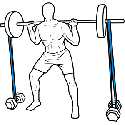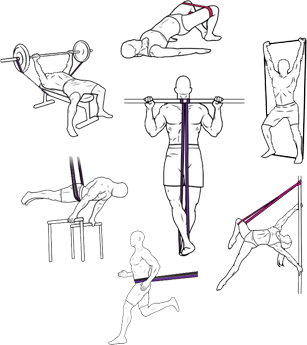You’ve put in the hard work at this point and your calisthenics exercises are improving. Your shoulders and hips are becoming more open and starting to move more freely. Or you just happen to be mobile and are able to move in all the ways I described in Part I, and you get to ‘skip’ the mobility work (which you should still be doing as a way to maintain or increase the mobility you have). Now we get to chase the weightless, floaty feeling of the handstand.
So now that we have done our mobility work for the handstand, we need to build a base that will see us spending our first few seconds in a freestanding handstand. This base revolves around creating strength and adding it mobility we have gained, and using that strength and mobility to create balance. As such, we will spend lots of time on handstand-specific strength and creating an understanding of what our freestanding calisthenics handstand ‘feels’ like, so we can recognize what keeps us upside down.
There is minimal calisthenics equipment required. Physically, we will need:
1) Strong and well-prepared wrists, to minimize the risk of injury and or pain.
2) Elbows that are willing to lock out and stay that way.
3) Shoulders that are strong enough to hold your bodyweight up and hold it up there.
4) Shoulder rotators and upper back muscles that activate and stabilize your shoulders to ensure that your shoulders remain healthy.
5) A strong, active core that increases body stiffness and supports the shoulders in their efforts.
6) Legs and hips that can stay stiff and straight to ensure less body movement during the handstand.
Mentally, I also recommend having or training:
1) The awareness to know when your form is getting sloppy, so that you can tighten it up or stop the session (this ensures that you aren’t training your body into poor form).
2) The ability to scan your body for any loose parts that are reducing your bodily stiffness.
3) Patience. This process can take time for many. Enjoy the journey.
4) A mindset of experimentation. Try things, see if they make your handstand chances go up. Record these experiments so you can remind yourself. There is a time where your body will simply remember, but this is not that time yet. For now you should remember for your body.
5) The ability to enjoy handstanding. If you don’t enjoy doing it, why spend the time learning it?
As I mentioned earlier, strength, mobility and balance must all come together for a handstand hold. A problem people often run into when developing the strength for the handstand is that they aim to increase strength at all costs, which can lead to bad habits (neural patterns), poor balance and a possible loss of mobility. These will all slow or stop your handstand gains, so it is important to make sure all the work you do is of the best quality. Train as often as you can produce quality work and for as long as you can produce quality, and your handstand will move more quickly than you might first expect, and more quickly than those grinding to exhaustion. Keeping this in mind we want to work up to (this means over time):
1) 3 sets of 30 repetitions of wrist raises (with the ability to do 15 in each set in a straddle push up position), 3 sets of 10 back handed push ups in a full position and 3 sets of 10 straddle wrist rolls.
2) 3 sets of 20 second gymastic ring supports (externally rotated) - these are among the most calisthenics equipment needed
3) 2 sets of 1 minute hanging.
4) The ability to shoulder dislocate in the equivalent of your snatch grip with all fingers connected to the bar for multiple reps (using a thick band can help stop cheating when using a bar because loss of grip will make you let go of the band).
5) 2 sets of 1 minute in a chest-to-wall handstand (completely active throughout the body for the entire minute), preferably off the wall with a band assist if possible.
6) 2 sets of 45 seconds in a hollow body hold (once again completely active throughout the body).
7) Double footed entries (tuck jumps) into a handstand with a success rate of at least 60% across a week (do 5 sets of 5 and record how many you manage to catch). The tuck jumps will make split leg kick ups much easier to do.
8) The ability to do 10 heel pulls and 5 toe pulls without falling over (separately, using a wall as your compass.
If you have played with handstands before, aim to reach these baseline figures over 6-8 weeks, and if you have not, aim to reach these in 12 or so weeks. You can find your gymnastics rings and other baseline calisthenics equipment right here. Now happy handstanding!
Article written by Joel Mullen. Acknowledgments to: Harry Williams (@holisticmovement), Joe Worthington (@jbjoey), Mike Makossa.



